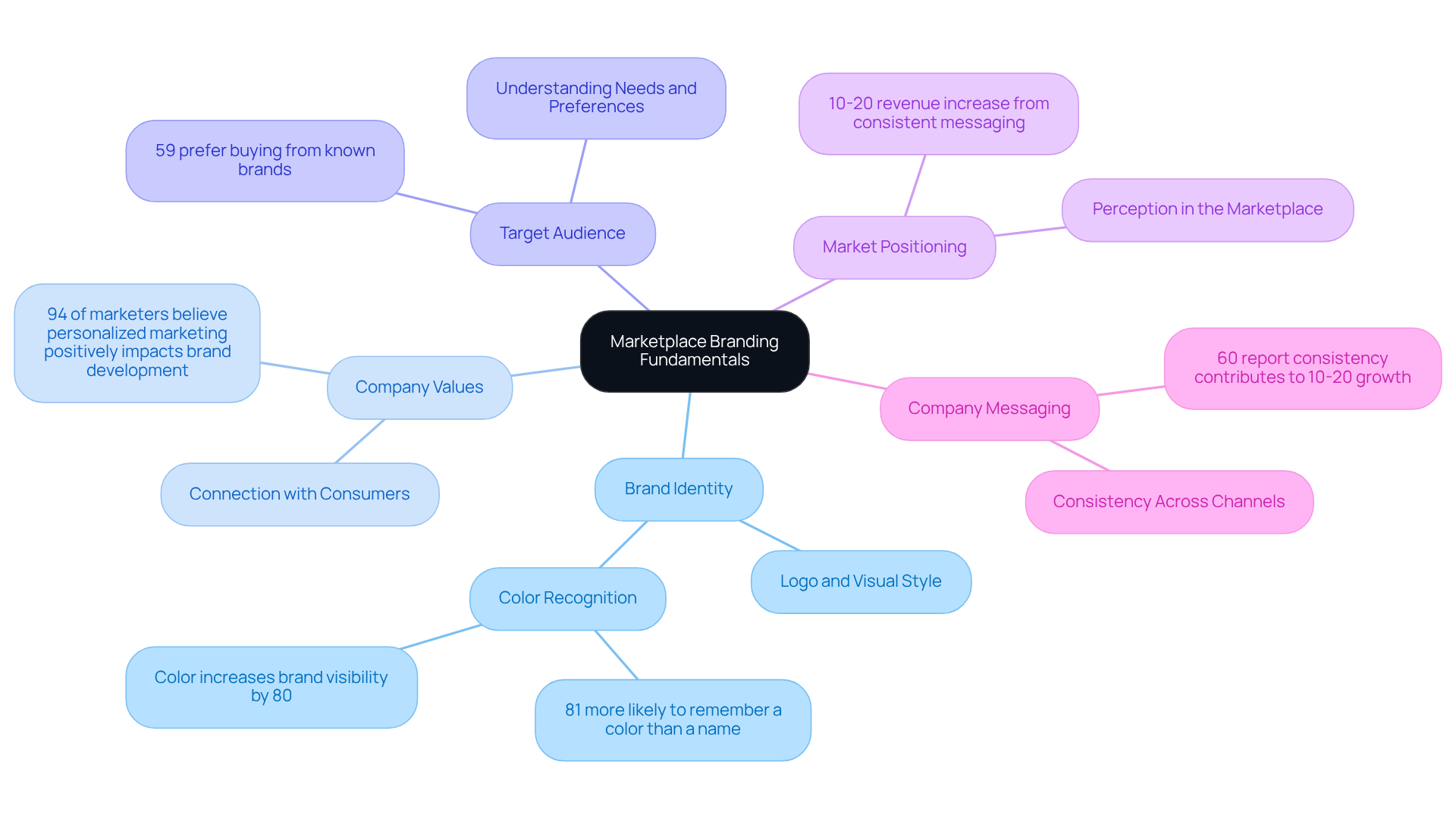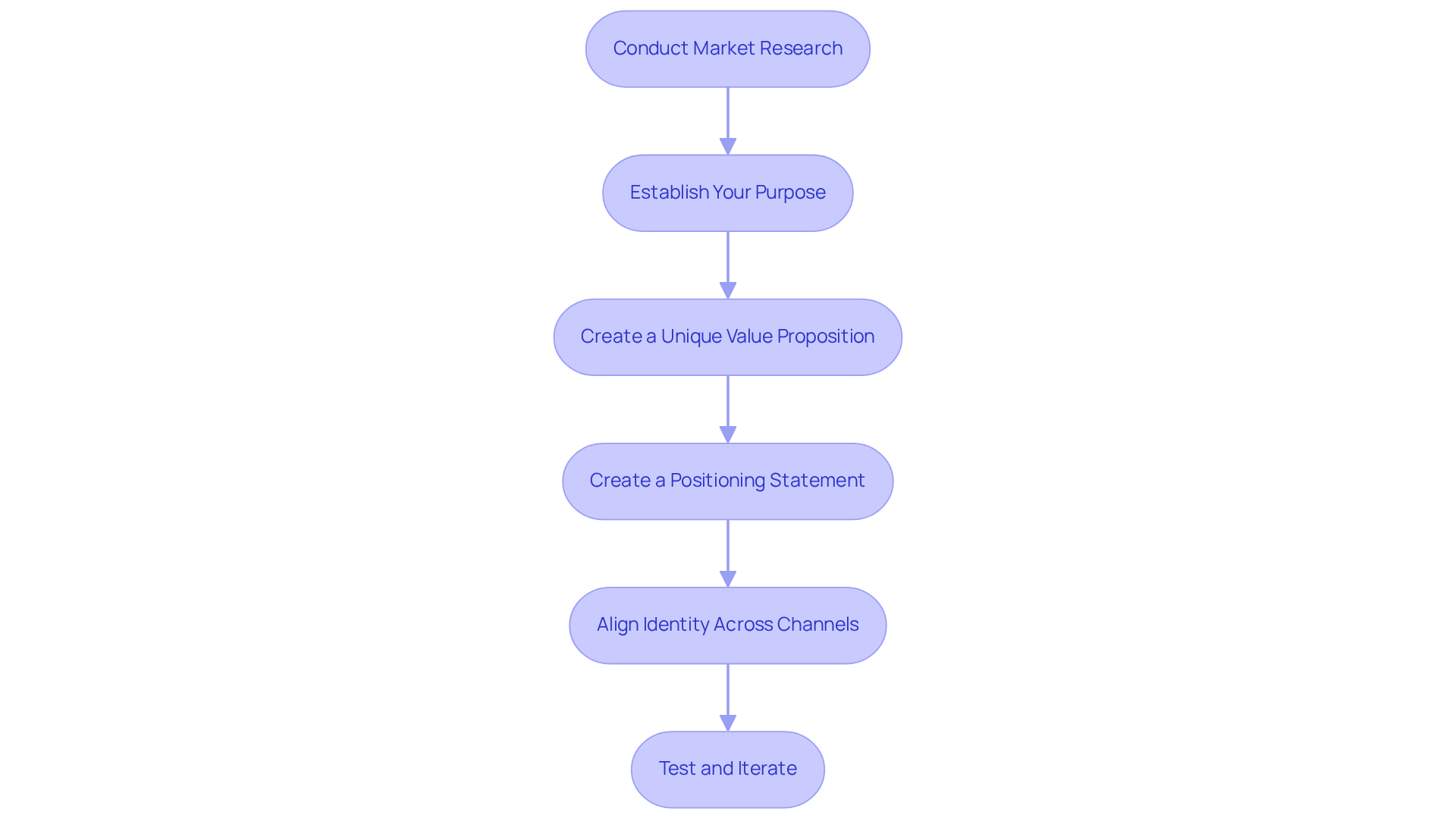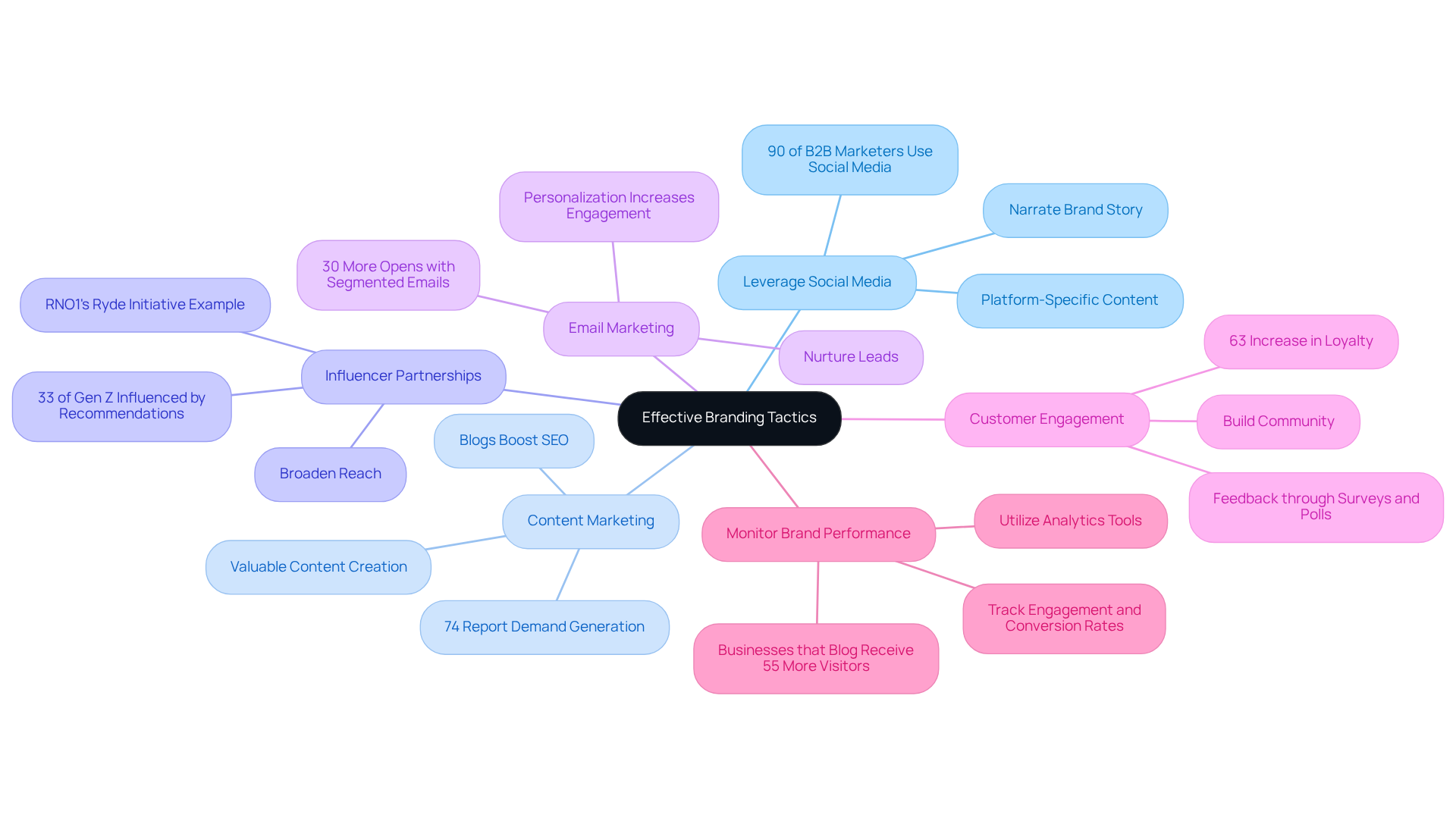Overview
This article delves into the challenges that tech startup founders face when trying to master a marketplace brand strategy for success. It's essential to recognize the struggle of:
- Defining brand identity
- Aligning with company values
- Understanding the target audience
- Positioning in the market
- Maintaining consistent messaging
These elements can feel overwhelming, but they are crucial for building a brand that resonates.
Imagine navigating a competitive landscape where every decision feels weighty, and the pressure to stand out is immense. Many founders experience this pain, feeling lost amidst the noise of the marketplace. However, there is hope. By outlining actionable steps and effective branding tactics, such as leveraging social media and content marketing, founders can cultivate a strong brand presence.
We invite you to embrace these strategies, knowing that they can lead to a more profound connection with your audience. Each step you take toward understanding your brand's essence and communicating it effectively is a step toward success. Remember, you are not alone in this journey; many have walked this path and emerged stronger. Together, we can build brands that not only thrive but also resonate deeply within their communities.
Introduction
Mastering a brand strategy in the competitive landscape of marketplaces is not just important; it is essential for tech startups striving for success. Many founders find themselves grappling with the core elements of branding—identity, values, and audience engagement. This struggle can deeply affect a company's ability to connect with consumers on a meaningful level. With countless brands competing for attention, it’s natural to feel overwhelmed. How can you, as a founder, ensure your marketplace brand not only stands out but also fosters lasting connections with your audience?
This journey can be daunting, filled with uncertainty and pressure. But remember, you are not alone in this. Many have walked this path and faced similar challenges. The good news is that there are effective strategies to help you navigate this landscape. By focusing on your unique identity and values, and actively engaging with your audience, you can create a brand that resonates deeply. Together, we can explore these strategies and support one another in building brands that truly connect and thrive.
Understand Marketplace Branding Fundamentals
Mastering your requires a crucial understanding of the core elements of branding, particularly when navigating the challenges faced by many tech startup founders today.
Brand Identity: Think of your logo, color scheme, typography, and overall visual style as the face of your business. A compelling identity not only sets you apart from competitors but also enhances recognition. Research shows that consumers are than its name. At RNO1, we embrace a to create a cohesive and memorable identity that truly resonates with your audience.
: Clearly defining what your business stands for—whether it’s sustainability, innovation, or customer-centricity—can profoundly connect with consumers. In fact, . This highlights the importance of aligning your values with consumer expectations. Our organization is dedicated to ensuring your values are effectively conveyed through design, nurturing strong .
: Identifying your ideal customers is essential. By understanding their needs, preferences, and behaviors, you can tailor your efforts to create a marketplace brand that resonates with them. Approximately 59% of consumers prefer to buy new products from companies they already know, underscoring the significance of building relationships with your customers. At RNO1, our design strategies are crafted to engage your target audience effectively across various touchpoints, fostering connection and trust.
Market Positioning: Consider how you wish your product to be perceived in the marketplace. This involves examining competitors and recognizing the gaps your company can fill. Brands that maintain consistent messaging across platforms can see revenue increases of 10-20%. The strategic rebranding of Founder's Haven by our organization exemplifies how effective positioning can empower modern founders for .
Company Messaging: It’s vital to create a consistent message that reflects your organization’s values and unique selling propositions. This messaging should . Consistency is key; . At RNO1, we ensure that your messaging aligns with our design-oriented approach, crafting a cohesive narrative that truly speaks to your audience.
By mastering these fundamentals and embracing RNO1's commitment to design-driven solutions, you lay a strong foundation for a product strategy that can adapt to the ever-evolving market dynamics and meet consumer expectations with compassion and clarity.

Define Your Brand Strategy and Positioning
Defining your can feel overwhelming, especially for tech startup founders navigating a competitive landscape. It's essential to understand the challenges you face as you strive to carve out your place in the market. But don't worry—by following these actionable steps, you can build a brand that speaks to your audience's heart.
- : Start by analyzing your competitors and identifying market trends. Gather insights about your intended demographic through tools like surveys, focus groups, and social media analytics. This understanding will empower you to make informed decisions.
- Establish Your Purpose: Take a moment to reflect on why your entity exists beyond making a profit. Articulating this purpose is crucial; it should resonate deeply with your target audience and guide your branding efforts. When your purpose is clear, it creates a .
- Create a : What makes your company stand out? This could be your product features, exceptional , or the story behind your brand. Define this uniqueness in a way that's compelling and easy to communicate, as it will be the cornerstone of your identity.
- : Formulate a brief declaration that encapsulates your unique value and intended market. For instance, 'For [target group], [label] is the [category] that [unique advantage].' This statement will serve as a guiding light for your messaging.
- : It's vital to ensure that your identity, messaging, and values are consistently represented across all platforms—your website, social media, and marketing materials. This alignment fosters trust and recognition among your audience.
- Test and Iterate: Once your identity plan is in place, evaluate it with your audience. Collect feedback and be ready to make changes based on their responses. This iterative process ensures that your identity resonates effectively and evolves with your audience's needs.
By embracing these steps with compassion and diligence, you can develop a strong marketing strategy that positions your marketplace effectively in the minds of consumers. Remember, you're not alone on this journey—support and community are just around the corner.

Implement Effective Branding Tactics
Implementing effective branding tactics can feel overwhelming for many tech startup founders. It’s crucial to connect with your audience and establish a strong marketplace brand presence. Here are some :
- Leverage Social Media: Social media platforms like Instagram, Facebook, and LinkedIn can serve as vital tools for narrating your brand story and connecting with followers. Tailor your content to resonate with each platform's unique audience. Remember, 90% of B2B marketers utilize social media for content distribution, highlighting its importance in your strategy.
- Content Marketing: Creating valuable content that addresses the needs and interests of your target audience is essential. This could be in the form of blog posts, videos, infographics, or podcasts. Such content not only informs but also positions your company as an industry leader. In fact, .
- Influencer Partnerships: Collaborating with influencers who align with your brand values can significantly broaden your reach. Their endorsements help establish credibility, as 33% of Gen Z consumers are influenced by these suggestions. For instance, showcases how strategic influencer partnerships can enhance e-commerce engagement and foster community involvement.
- Email Marketing: Focused email campaigns are a wonderful way to nurture leads and keep your audience informed about new products and promotions. Personalization is key, as segmented emails can drive 30% more opens and 50% more clickthroughs, making your communication feel more personal and engaging.
- Customer Engagement: Building a community around your product is vital. Encourage , polls, and social media interactions. Understanding their preferences can lead to improvements in your offerings. Engaging customers can result in a 63% increase in loyalty, as highlighted by . The Ryde initiative exemplifies this by fostering a community of ambassadors who actively connect with their networks.
- Monitor Brand Performance: Utilizing to track your branding efforts is essential. Keep an eye on metrics such as engagement rates, website traffic, and conversion rates to assess what works best for you. Notably, , underscoring the importance of consistent content evaluation.
By embracing these nurturing tactics and leveraging innovative strategies like those from [RNO1's Ryde initiative](https://blog.rno1.com/10-strategies-for-effective-branding-in-sport-engagement), you can bring your marketplace brand strategy to life and create a meaningful impact.

Conclusion
Mastering a marketplace brand strategy can feel daunting for tech startup founders striving for success in a competitive environment. It's essential to grasp the fundamentals of branding—establishing a compelling brand identity, aligning your company values with what consumers expect, and effectively identifying and engaging with your target audience. By focusing on these core elements, you can create a memorable presence that resonates with consumers and fosters loyalty.
Many founders grapple with the challenges of market positioning, consistent messaging, and the execution of effective branding tactics. It’s crucial to conduct thorough market research, articulate a clear purpose, and leverage digital platforms to build a brand that truly stands out. Nurturing customer relationships through engagement and feedback not only enhances loyalty but also promotes growth, highlighting the importance of a strategic approach to branding.
Ultimately, the success of your marketplace brand hinges on the ability to adapt to evolving market dynamics while maintaining a clear and consistent identity. Embracing innovative strategies, integrating your unique value propositions, and actively engaging with your audience can cultivate a brand that captures attention and fosters enduring connections with consumers. Remember, you are not alone on this journey; by sharing your experiences and learning from others, you can navigate the complexities of branding with confidence and compassion.
Frequently Asked Questions
What are the core elements of marketplace branding?
The core elements of marketplace branding include brand identity, company values, target audience, market positioning, and company messaging.
How does brand identity impact a business?
Brand identity, which encompasses elements like logos, color schemes, and typography, serves as the face of the business. A compelling identity enhances recognition and sets a company apart from competitors, making it more memorable to consumers.
Why are company values important in branding?
Clearly defining company values, such as sustainability or innovation, helps connect with consumers. Personalized marketing aligned with these values can significantly impact a company's development and foster strong customer loyalty.
How can understanding the target audience improve branding?
Identifying and understanding the needs, preferences, and behaviors of your ideal customers allows you to tailor your branding efforts, making it more likely to resonate with them and build lasting relationships.
What is market positioning and why is it significant?
Market positioning involves determining how you want your product to be perceived in the marketplace, examining competitors, and identifying gaps. Effective positioning can lead to revenue increases and enhance brand success.
Why is consistent company messaging crucial?
Consistent messaging that reflects a company's values and unique selling propositions is vital across all marketing channels. It contributes to growth and helps create a cohesive narrative that resonates with the audience.
How can RNO1 assist with marketplace branding?
RNO1 offers a design-focused approach to branding, ensuring that all elements such as identity, values, audience engagement, positioning, and messaging are effectively aligned to create a strong marketplace brand.




